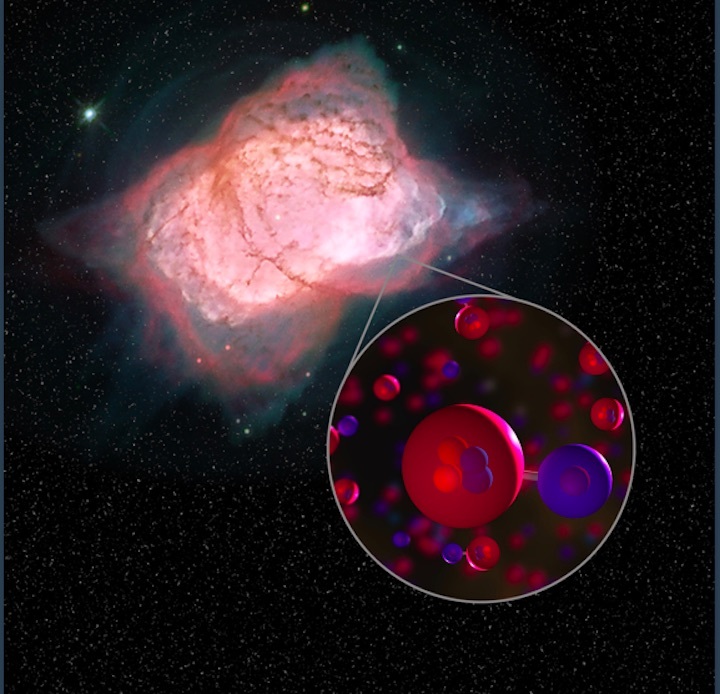9.09.2019

Researchers using SOFIA have made the first-ever detection of the helium hydride molecular ion (HeH+) in interstellar space. This discovery refines our understanding of the underlying chemical networks that control the formation and destruction of this special molecular ion, a first step toward the huge diversity of molecules in the Universe today.
Understanding how that early gas (mostly hydrogen and helium) evolves into the Universe filled with galaxies, stars, and planets we see today, some 13.8 billion years later, remains one of the most important goals of modern astrophysics. When temperatures in the early Universe had fallen below ~4,000 K, the light elements produced in the Big Bang began to combine. Ionized hydrogen interacting with neutral helium created the “Universe’s first molecular bond” in the helium hydride ion (HeH+). Destruction of HeH+ created one of the earliest paths to forming molecular hydrogen (H2), the most abundant and significant molecule in the Universe. The growing abundance of such molecules influenced the structure of the early Universe by providing a dominant mechanism for gas to cool and form stars.
Having been predicted by chemical models and created in the laboratory, decades-long searches for this elusive molecule in an astrophysical environment turned up short – until now.
HeH+ was detected toward the planetary nebula NGC 7027 with the German REceiver for Astronomy at Terahertz Frequencies (GREAT) spectrometer aboard SOFIA. The hard radiation field produced by the central white dwarf star (T > 100,000 K) combined with a high density of hydrogen and helium, proved to be an excellent place where HeH+ could form today. Comparing the observed J=1-0 emission at 149 µm to detailed models of the nebula’s helium and hydrogen ionization fronts, the team found the observed flux was a factor four times brighter than predictions. The results constrain the radiative association creation (He+ + H -> HeH+ + hν) and the dissociative recombination rates (HeH+ + e- -> He + H) in the NGC 7027 environment. This in turn may stimulate future advance studies of these important reactions and of the corresponding radiative association under conditions of the early universe (He + H+ -> HeH+ + hν). Future studies of HeH+ (J=1-0 and J=2-1 at 149 and 75 µm, respectively) can help us further study overlap ionization regions in planetary nebulae.
SOFIA made this discovery possible by accessing the electromagnetic spectrum in the region where the HeH+ can be detected and having the sensitivity and technology to measure the rotational ground-state J=1-0 transition at 149.137 µm with high-enough spectral resolution to separate it from the nearby Λ-doublet of CH at 149.09 and 149.39 µm. CH is among many molecules abundant in photodissociation regions, and had been previously detected in NGC 7027 with the Infrared Space Observatory’s Long Wavelength Spectrometer (LWS). However, LWS’s spectral resolution was too low to distinguish the adjacent HeH+ transition from the CH, and the authors from that study provided an HeH+ upper limit (see Liu, X.W. et al. MNRAS, 290, L71-L75 [1997]). The latest advances in terahertz technology enabled this first unambiguous HeH+ detection in interstellar space, by GREAT on SOFIA.
Scientists on the airborne observatory SOFIA detected the first type of molecule that ever formed in the universe. They found the combination of helium and hydrogen, called helium hydride, in a planetary nebula near the constellation Cygnus. This discovery confirms a key part of our basic understanding of the early universe and how it evolved over billions of years into the complex chemistry of today. Credits: NASA/Ames Research Center
Quelle: SOFIA Science Center
